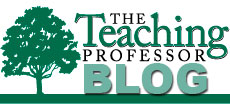More Evidence that Active Learning Trumps Lecturing
The June-July issue of “The Teaching Professor” newsletter highlights a study you don’t want to miss. It’s a meta-analysis of 225 studies that compare STEM classes taught using various active learning approaches with classes taught via lecture. Read about how “the results indicate that average examination scores improved by about 6 percent in active learning sessions, and that students in classes with traditional lecturing were 1.5 times more likely to fail than were students in classes with active learning.” Carl Wieman, a Nobel Prize-winning physicist who now does research on teaching and learning, describes the work as a “massive effort” that provides “a much more extensive quantitative analysis of the research on active learning in college and university STEM courses than previously existed.” And what does he make of these results? “The implications of these meta-analysis results for instruction are profound, assuming they are indicative of what could be obtained if active learning methods replaced the lecture instruction that dominates U.S. postsecondary STEM instruction.” That’s a long way from the guarded language usually found in commentaries on scientific results. 
The findings of the meta-analysis aren’t are all that unexpected. Study after study, not just in the STEM fields, but pretty much across the board, have reported findings that favor active learning approaches over lecture. Most of us, especially readers of a blog like this one, don’t need to be convinced. We know that learning is harder from the sidelines. If deep understanding is the objective, then the learner had best get out there and play the game. Watching others problem solve, think critically, paint watercolors or start an IV may provide a sense of how it’s done, but that’s not how you learn to perform on the field.
There is less defense of lecture than there used to be and more apologizing by those who do:
“I have to lecture. What else can you do in these large classes?”
“I can’t get the content covered if I don’t lecture.”
“Students want me to lecture.”
Valid excuses? Not really. Examples of active learning strategies being used in large classes abound. Teachers may cover the content, but if that doesn’t promote learning, does it really matter that it’s been covered? And since when did education become governed by what learners may think they need or want?
But despite what we know, those apologies, and the resultant feelings of guilt, there’s still an awful lot of lecture happening in most fields and on most campuses. It remains our default instructional mode. We go there first and we stay there the longest. Lecturing allows us to pledge allegiance to the content.
I know, I’m sounding adamant, but the evidence is in. The case is closed. Active learning wins. If we aspire to make our practice evidence-based, then we need to do a very honest analysis of how often we’re finding ourselves front and center, covering the content. We need to more aggressively raise the issue with our colleagues, in our departments, at our institutions and within our professional associations.
No, lecturing doesn’t need to be against the law with harsh sentences levied against those who continue to do it. I still believe there are times when teachers need to share their expertise, when efficiency makes telling students the only reasonable option. Teachers can explain things clearly, cogently and with passion. There’s a place for that in the classroom as well, but it’s a much smaller place than it currently occupies in many classrooms.
It is true that we still don’t know as much about active learning as we need to know. For example, we don’t how much is needed to make a difference in a class session or across the course. We don’t know which of the many active learning approaches (group work, clickers, online discussion, hands-on experience, etc.) work best with what kinds of content and for what kinds of learners. We’ve got lots to learn, but we definitely know enough to challenge ourselves and our colleagues to step back from lecture and move forward with approaches that feature students taking action.
References: Freeman, S., Eddy, S.L., McDonough, M., Smith, M.K., Okorafor, N., Jordt, H., and Wenderoth, M.P., (2014). Active learning increases student performance in science, engineering, and mathematics. Proceedings of the National Academy of Sciences (PNAS), 111 (23), 8410-8415.
Weiman, C.E., (2014. Large-scale comparison of science teaching methods sends clear message. Proceedings of the National Academy of Sciences (PNAS), 111 (23), 8319-8320.
*This article originally appeared in “Faculty Focus: Higher Ed Teaching Strategies From Magna Publications.”
Teaching, Employee and Faculty Resources
Visit utah.edu/faculty and utah.edu/staff for essential teaching tools, trainings, reference material, health, safety and business resources. Keep your skills up-to-date and learn some new ones with help from these university resources:
Staff Development
- Training & Development
- New Employee Orientation
- Workshop Calendar
- Continuing Education
- Staff Council
Teaching Resources
- Center for Teaching & Learning Excellence
- Teaching & Learning Technologies
- Registrar Office – Faculty
- Marriott Library
- Eccles Health Sciences Library
- S.J. Quinney Law Library
- Academy of Health Science Educator
